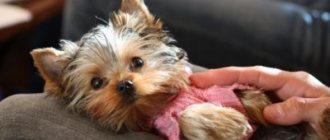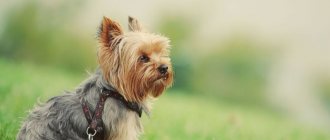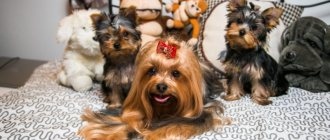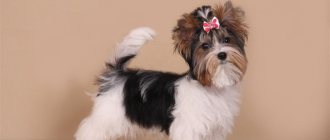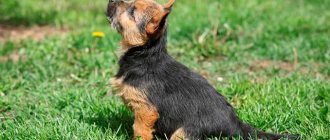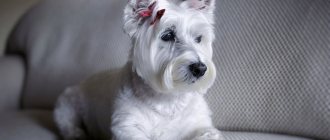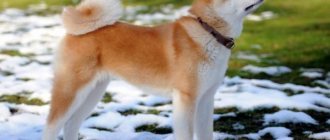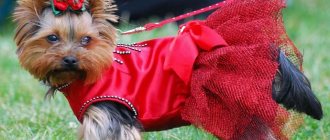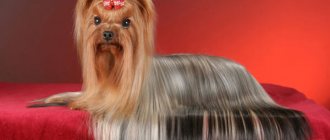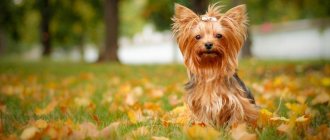History of the breed
Information about the origin of Yorks, thoroughly overgrown with legends, is confusing and ambiguous. And it is unlikely that it will be possible to briefly describe the history of the Yorkshire Terrier breed, since selection was carried out over several centuries and has many interesting aspects that I would like to cover.
At the very beginning of the creation of the breed, Old English terriers were used, which varied greatly in type. Sometimes, by luck, the people who participated in the creation managed to introduce a very successful combination of inherited traits into the genotype of animals.
It is not possible to document the development of modern Yorkies, since in distant centuries the selection of the best representatives was carried out by simple and uneducated people.
In those days, the lands where it was possible to hunt in England were prohibited for commoners. Then a law was even passed that allowed them to have only small dogs, with which, it was assumed, the peasants would not be able to go hunting. For example, a dog as small as a spaniel could only be owned with a special permit.
For all other peasant pets, there was a special measure in the form of a loop, the diameter of which was approximately 17 cm. If the dog could crawl through it, then the commoner was allowed to keep the animal. That is why in Great Britain there are so many small breeds with which ordinary people went hunting in the fields for gophers, small birds and rabbits.
These small dogs guarded houses and destroyed small rodents. Cats in those days were considered “dirty” animals; they were out of favor and were burned en masse at the stake.
How to determine the age of a Yorkshire Terrier
Often people do not buy puppies, but take them from the street or from shelters. In this case, it is necessary to determine the age of the Yorkshire Terrier. Only then will the owner be able to control his health and choose the right diet.
The main way is to examine your teeth:
- 25–35 days – fangs erupt;
- 35–60 days – incisors and premolars appear;
- 3–4 months – teeth change begins;
- 7–14 months – the incisors are completely white, have 3 teeth;
- 1.5 years – the lower incisors wear down a little;
- 2 years – the lower incisors continue to wear down, the upper ones are leveled;
- 3 years – yellow plaque is noticeable, tartar may appear;
- 5 years – all incisors are worn out;
- 6 years – all teeth are covered with a yellow coating, signs of wear are clearly visible;
- over 10 years - all crowns are almost worn out, caries appears, and teeth may fall out.
The condition of the teeth varies depending on the living conditions and diet of the animal. Therefore, it is very difficult to determine the exact age of the Yorkshire Terrier. But if you take into account other factors - muscle tone, coat structure, look - you can get a more accurate result.
Any dog breeder wonders at what stage of development his ward is at. Yorkies are small breeds - the age of the dog by human standards will look like this:
Dog age, yearHuman age, year
| 1 | 15 |
| 2 | 23 |
| 3 | 28 |
| 4 | 32 |
| 5 | 36 |
| 6 | 40 |
| 7 | 44 |
| 8 | 48 |
| 9 | 52 |
| 10 | 56 |
| 11 | 60 |
| 12 | 64 |
| 13 | 68 |
| 14 | 72 |
| 15 | 76 |
| 16 | 80 |
| 17 | 84 |
| 18 | 88 |
| 19 | 92 |
| 20 | 96 |
Participation in the selection of the Old English breed
In the history of the Yorkshire Terrier breed, during the reign of King William IV, namely, in 1965-1835, a dog was noticed that was called the Waterside Terrier. She was medium-sized, weighing 3-6 kg and height at the withers 27 cm, with fairly long gray-blue hair.
At that time, fighting these dogs with rats was a very popular event among common people. For a certain amount of time, the Waterside Terrier had to kill a number of rats. The winners were worth their weight in gold. Documentary evidence of the existence of such dogs can be considered a note in a newspaper of those times, which described in detail an animal named Polly, who was the winner, as well as the name of her owner - Mr. John Richardson.
Nutrition. What to feed your Yorkshire Terrier at home?
An incorrect feeding regimen, too large portions, as well as cheap and low-quality food can lead to gastric volvulus. This is a deadly disease!
Bad breath indicates problems with the functioning of the stomach.
The smaller the puppy, the more often it needs to be fed. In this case, the portions should be very small.
- age 1-2 months - 6 meals a day;
- age 2-3 months - eating 4-5 times a day;
- age 3-6 months - the number of meals is reduced to 3-4 times;
- age 6-8 months - need to feed 2-3 times a day;
- over 8 months - two meals a day, less often - once a day.
Don't feed your baby at night! This is harmful to his ventricle. 60% of animals that were hospitalized due to gastric volvulus suffered from eating too rich a dinner.
Harmful foods for the Yorkshire Terrier must be completely excluded from the diet.
- Pork . Very harmful to the liver.
- Sweets . The product leads to obesity.
- Salted, fried and smoked . This is initially harmful food, which negatively affects not only the health of the animal, but also the well-being of the owner.
- Milk . Poorly digested and causes stomach upset.
- Bones . May injure the digestive tract.
- Potato . Contains a lot of starch.
- Legumes . Such products increase gas formation.
- Raw fish . Contains substances harmful to dogs, as well as small bones.
- Broths, citrus fruits, juices . May cause allergies.
If for some reason you do not want to give your pet high-quality ready-made food, you need to provide your Yorkshire Terrier with a varied diet of healthy foods. What to feed your Yorkshire Terrier at home?
- Meat . Should make up about a third of all dishes. Give preference to the muscle part, heart, and liver over beef, veal, chicken, and turkey.
- Porridge . You can give monograin porridge or cook several cereals at once: rice, buckwheat, millet, wheat.
- Vegetables . For better absorption of vitamins, add a drop of vegetable oil to boiled vegetables. Carrots, all types of cabbage, beets, zucchini, pumpkin, and greens are considered beneficial for Yorkies.
- Seafood . Boil and serve with porridge.
- Dairy . Cottage cheese and kefir are irreplaceable sources of calcium.
The three pillars of the daily diet are porridge, meat and vegetables. Each component is 1/3 of the dish. 2-3 times a week, meat can be replaced with cottage cheese and seafood.
Participation in the Australian Terrier breed
Another person who had a hand in the history of the Yorkshire Terrier breed was a certain Mr. Spink, who brought a male Australian Terrier named Punch from Australia. This male had won 13 shows in Australia by that time.
The breeder, Mr. Spink, by mating female Waterside Terriers with Punch, obtained offspring distinguished by silky hair, very small size and wonderful color. One of Punch's descendants was the famous Hudersfield Ben, who is considered the father of the Yorkshire Terrier breed.
How to choose the right Yorkshire Terrier puppy
To choose a Yorkie puppy, you should study the breed standard, talk to current owners and find a reliable kennel. It is not recommended to purchase dogs from private individuals - there is a high risk of getting a sick or not purebred animal. You need to talk to the breeder, the person in charge:
If the breeder remains silent or only praises the litter without pointing out the shortcomings, it is better to refuse the purchase.
In a healthy baby:
- clear view;
- clean eyes, ears and nose;
- shiny wool;
- moderately well-fed physique.
A Yorkshire Terrier puppy should be friendly, curious and playful. You should not take away the most active baby - he will cause a lot of trouble in the future. To find “your” pet, it is recommended to spend a few minutes alone with each of them.
The baby must have a veterinary passport with vaccination records, and his parents must have a pedigree issued by the RKF. If you choose the right puppy, he will live a long and happy life and become a loyal friend.
Who is better, a boy or a girl?
When choosing a Yorkshire Terrier puppy, you need to determine in advance the gender of the future pet - boy or girl. They have different habits and temperaments, so you should not take the only dog left from the breeder. There is a high risk of being disappointed in your pet. So who is better - a boy or a girl?
It is known about Yorkie boys that they are more willful. During adolescence, a male Yorkshire Terrier will definitely try to take a leadership position. The owner should be patient and purposefully raise the puppy. Then he will grow into a kind and obedient dog.
The York boy will mark his territory. Having sensed a female in heat, he may stop responding to commands and run away. However, a purebred dog will make a good producer.
The Yorkshire Terrier girl is more affectionate and devoted. She is not prone to dominance and needs more communication with a person. Twice a year, females enter a problematic period - estrus. At this time, they need to be protected from communication with males if the owner does not intend to engage in breeding.
It is believed that York girls learn faster. However, each case is individual. How a pet will grow up depends more on the conditions of keeping and upbringing than on its innate qualities.
It is impossible to say for sure who is better - a boy or a girl. Both sexes have both advantages and disadvantages. The choice depends on the experience and character of the owner, as well as on the goals pursued.
Participation in the Scottish Scotch Terrier breed
When the Industrial Revolution began at the end of the 18th century, Scottish peasants flocked to Yorkshire in search of work, taking with them their pets - small, cute dogs. These were Scotch Terriers, which combined such breeds as Aberdeen, Highland, Skye, Paisley, Cladesdale, Scotch, and Sortie.
Back then, breed names were often assigned depending on the area of their origin. All these terriers were, in general, similar. However, Scotland is a country with a varied landscape, and people living in the highlands and lowlands had very little interaction with each other. Therefore, their dogs differed in external characteristics.
The Paisley Terrier Standard of 1884 defined the animals' coat colors as varying shades of blue, with preference given to the darker ones. The head and legs should have been colored lighter than the body. Unfortunately, the Paisley Terrier Club was abolished, but some fans of the breed organized another one with the name “Cladesdale Terrier”. The breed standard has changed slightly: the blue and silver coat color of the Paisley became the Cladesdale - blue with golden bronze tan.
The history of the Yorkshire Terrier breed, and photographs from those times demonstrate this, is eventful and varied. Many dogs from different countries took part in the development of modern Yorkies.
Buy a Yorkshire Terrier
Yorkies do not have an undercoat as such, and their hair structure is similar in structure to human hair. In connection with this factor, a very important point should be noted, which is very popular with people prone to allergies. These dogs practically do not shed. In addition, the owners of such pets do not regularly remove hair from interior items: there is simply none.
All lovers of this breed need to know that puppies are born only black in color and only as they grow and mature do they acquire the natural shades characteristic of Yorkies. All individuals, regardless of gender, are endowed with good nature and intelligence, as well as a peaceful disposition. Despite their rather modest size, they will not be afraid of any danger, and will protect their owner and themselves until their last breath.
What to pay attention to
It is better to choose a Yorkshire Terrier puppy with a specialist, but if this is not possible, you should pay attention to a number of points that will help protect the future owner from negative consequences. That's why:
- The “calling card” of this breed is the brand.
- The puppy should have straight limbs and a straight back.
- The coat must be clean, undamaged and uniform, without bald spots or scratches.
- The eyes, nose and ears should not show signs of inflammatory processes.
- Both the lower and upper jaws should have 6 teeth, forming a regular, scissor-like bite.
- The inner surface of the ears should be clean and have a soft pink tint.
- The puppy should feel confident, orienting itself in space and moving freely.
- The puppy's breathing should be smooth and clear, without any extraneous sounds.
It is equally important to pay attention to the general condition of the puppy, which may indicate the conditions in which the animals are kept by the breeder. This can also be indicated by the physical condition associated with the degree of fatness of the animal.
Interesting moment! If you plan to use the dog in various shows or exhibitions in the future, then quality indicators should come to the fore. This applies to both behavioral characteristics and characteristics of the body structure.
If the puppy is inquisitive and responds adequately to any external stimuli, then this is evidence of good intelligence and proper mental development.
Puppy price
The cost of Yorkshire Terrier puppies is not exorbitant, since the breed is quite fertile, and its care is not particularly special. Therefore, puppies of this breed are affordable for any client. You will have to pay from 15 to 50 thousand rubles for a puppy, depending on the class of the puppy, exterior features, gender, and the availability of accompanying documents.
Kitty and Crab
There is much more interesting in the history of the Yorkshire Terrier breed. For example, Manchester also had its own small Old English terriers. In a book called "The History of Manchester" in 1771, they were described as small, shaggy dogs with crooked legs and black-and-bronze fur.
However, Manchester Terriers have become lost in history, replaced by more popular recognized breeds. In 1892, a certain Mr. Butman from Halifax wrote an article about the origin of the described breed, where he described two dogs: Old Crab and Kitty. The first was a hybrid Scotch Terrier, the second was a Skye Terrier from the Old English Terriers.
Old Crab had a long body, his legs and muzzle were painted bronze, and the hair on his body was long and straight. Kitty is a different type of dog. She had floppy ears and a large amount of blue fur without bronze tan. Like the Crab, she had no pedigree. Until 1851, Kitty brought 6 litters from Crab, then, changing owners, she brought another 44 puppies.
There was another dog from Scotland, whose name is lost. Her owner was considered to be Mr. Whitham, who also used this bitch to breed the breed. All three of these dogs are described in great detail. The descendants of these three dogs were used to improve the breed by mixing their blood with others that had the necessary qualities.
Care and maintenance
For the Yorkshire Terrier breed, care and maintenance should be limited to organizing regular walks, toileting, hygiene procedures and proper nutrition. The dog adapts very well to environmental conditions and is well suited for living in an apartment. Due to the small size of the pet, the apartment can be small, and he will feel great in it.
Terriers quickly learn to use the toilet, and for this they may need a regular tray, like a cat's. That is, they can do their “toilet” chores without waiting for walks. This is a big plus in their content.
Your pet's long fur requires extra attention. On the one hand, caring for the hair is not difficult, since it does not have an undercoat and therefore does not shed, but on the other hand, constantly ensure that the coat is not tangled and is clean. Gently combing and curling hair curlers solves tangling problems. Regular washing and application of special oil is the key to a beautiful looking and silky coat.
Caring for a Yorkshire Terrier, if she does not participate in exhibitions, also means cutting her hair 1-2 times a month. A stylish short haircut does not at all spoil the appearance of the dog, but, on the contrary, emphasizes its liveliness, activity and love of life. Also, short hair in the groove area and lower belly allows it not to get dirty and serves hygienic purposes.
Eyes and ears also need care. The fur on the face is combed every day so that it does not get into the eyes and irritate them. The corners of the eyes are regularly wiped with a cotton pad moistened with water, and if purulent discharge appears, you should contact a veterinarian, as this indicates an infection.
The Yorkshire Terrier's ears need regular inspection, and the hair in the ear canal is also regularly trimmed so that it does not trap dirt that leads to infections.
The dog has a very sensitive digestive system that quickly reacts to any mistakes in nutrition. With natural feeding, the majority of the diet consists of high-quality products: pieces of beef scalded with hot water, raw or boiled vegetables, egg yolks, cottage cheese, kefir. Owners who follow dry food diets should choose special foods designed for small dogs.
If a Yorkshire terrier appears in the house, caring for it also involves organizing walks. The dog does not need intense physical activity, but it should not necessarily have the opportunity to run, frolic, or play with a ball. This is also useful for the dog’s obedience and the elimination of nonsense, because a pet that does not fully expend energy may deteriorate in character.
A full walk is not a walk for “toilet” purposes, but spending time in a park or forest for 1-1.5 hours, when the terrier can run around to his heart’s content. When walking in the cold season, your pet wears a warm overall, as his delicate body can become hypothermic.
Where does the name of the breed come from?
So, the history of the Yorkshire Terrier breed and the origin of modern beautiful dogs no longer looks so mysterious. In 1873, several gentlemen organized the English Kennel Club, where pedigrees were registered and descriptions of dogs and breeds were compiled.
The bulk of influential terrier breeders from the non-sporting group of dogs lived in Yorkshire or nearby. Therefore, it was decided to give the breed the name Yorkshire Terrier.
For the first time, the son of Huddersfield Ben, Mozart, who won first prize at the 1870 exhibition, was named a Yorkshire Terrier.
Major versions
Version one
The Yorkshire Terrier dog breed, which arose relatively recently - in the second half of the nineteenth century - was bred in Great Britain.
It is worth noting such an interesting fact that initially small terrier-like dogs were used as hunters for various small rodents. The owners of these dogs were mainly poor people. After all, they were not allowed to have large dogs, which were used by poachers.
The homeland of the Yorkshire Terrier is considered to be the county of Yorkshire, as well as the county of Lancashire, which are located in northern England.
According to the first version, researchers believe that the Waterside Terrier, known in the late eighteenth and early nineteenth centuries, is the closest ancestor of the modern Yorkie. History has also preserved a description of such a terrier: a miniature dog with long gray-blue hair.
It was the Waterside Terrier that the poor kept as guards of their property from small rodents, and traders took them with them on trading expeditions for the same purpose.
Another interesting fact: scientists believe that terrier-like dogs helped miners in searching for underground gas. At that time, according to English law, miners were not allowed to take dogs deep into the mines. But since these animals easily fit under clothes due to their miniature stature, they could be carried with you unnoticed.
The upper strata of English society, noticing the nobility and nobility in the small rat-catcher terrier, began to breed smaller representatives of the new breed. The nobility began to give each other the resulting dogs as a special sign of attention.
Some scientists consider the Maltese, or Maltese, to be the ancestors of modern Yorkies. Perhaps they were crossed with Yorkshire terrier dogs to improve the quality of their coat. Although many scientists question this interesting fact, citing the fact that Maltese dogs have floppy ears and completely white coat color.
Manchester Terriers from Manchester are also considered to be the closest ancestor of the Yorkshire Terrier breed. Breeders were able to develop a subspecies of the long-haired Manchester Terrier with high-quality wool - shiny and silky.
Version two
The second version of the origin of representatives of this breed tells about such an interesting fact that the ancestors of modern Yorkies were brought at the end of the eighteenth century to the counties of Yorkshire, as well as to the county of Lancashire from Scotland. Scottish workers, due to the lack of jobs at home, moved to northern England in search of good earnings.
They brought small dogs, calling them Scottish Terriers (Scottish Terriers). After some time, such varieties of Scottish dog breeds appeared as the Paisley Terrier, Clydesdale Terrier, Cairo Terrier, and Skye Terrier.
Despite the fact that Paisley Terriers and Clydesdale Terriers have never been registered as independent breeds, they are, according to the second version, considered to be the ancestors of modern Yorkshire Terriers.
A completely new line of dogs was decided to be bred by weavers who began working in newly built English factories. As a result of long and painstaking work, they were able to get a dog with silky hair that reached to the ground. She had a basic steel-blue color, as well as golden-brown areas of her coat.
But the resulting Yorkshire terriers weighed slightly more - six to seven kilograms, and had a slightly elongated body. The new line of the Yorkshire Terrier quickly became the most popular of all terrier breeds existing at that time.
The most important of the first famous representatives of the breed in history is considered to be a Yorkshire terrier named Huddersfield Ben from Huddersfield. He was born as a result of inbreeding - interbreeding, in 1865. Unfortunately, he did not live long, only six years - he was shot down by the crew. But he left behind a huge offspring and seventy-four exhibition prizes.
The English Kennel Club registered the Yorkshire Terrier as a separate breed in 1886. The first society dedicated to breeding representatives of this breed was formed in 1898.
Very little information remains about the development of Yorkshire Terriers during World War II. There are only a few notes about the English exhibition in 1947, in which representatives of this breed participated.
In Germany, the Yorkshire Terrier was registered as a separate breed in 1940.
Despite the fact that dogs were brought to America in 1872, the American Kennel Club registered the breed only in 1878. In the fifties of the twentieth century, Yorkshire terriers ceased to be popular.
The fame of this breed was restored by the following interesting fact: during the war, one of the American soldiers named Bill Wine accidentally discovered a representative of the Yorkshire Terrier breed and gave him the nickname Smokey. He later sold it to Corporal William Wynn.
This dog helped military engineers build an airfield - it climbed through narrow underground pipes and laid cables, thereby saving the time and effort of military workers.
Smoky also helped the wounded in hospitals - she entertained them with all sorts of tricks, following the nurses everywhere. Because of this, it is considered to be the first therapy dog.
In the post-war period, she acted in films and participated in various shows. Since her death, six monuments have been erected in her honor across America.
The Yorkie came to Russia in 1971 as a gift to the famous Russian ballerina Olga Lepeshinskaya. The Mytishchi nursery, opened in 1991, became the very first in all of Russia. At the moment, there are more than seventy-five official nurseries in Russia.
What do you know about this breed? Tell us in the comments.
Huddersfield Ben - father of the breed
In the history of the Yorkshire Terrier breed, there is one dog that is considered the father of all Yorkies. This is, without a doubt, the famous Huddersfield Ben, the dog of breeder Joan Foster from Bradford, Yorkshire.
This baby was born in 1865. His owner Mrs Foster was the first female judge of the Kennel Club show in 1889. Huddersfield Ben won 74 prizes with his owner and was the father of a huge number of breed champions. He was killed by a cab in 1871.
Huddersfield Ben's son Tad, also owned by Mrs. Foster, is another famous representative of the history of the Yorkshire Terrier breed, and was described as having a short back and weighing 5 pounds, with a height at the withers of 9 inches. Ted was best in breed for 6 years.
Modern description and character of York
In the history of the Yorkshire Terrier breed, character was formed along with external data. Yorkies are very brave dogs, despite their miniature size. This trait was formed in them not over years, but over centuries. After all, there are no cowardly hunters. Only a brave dog will, without a doubt, rush into a hole for prey or crush the rats one after another until he destroys the entire brood, despite the fact that the rat may be the size of the hunter himself.
The character of these dogs also has such a feature as irrepressible activity. Yorkie is ready to chase the ball all day long, until the owner gives up and gets tired of playing with him. Along with these qualities, the breed has intelligence, balance, incredible intelligence and devotion to its owner.
He may be small, but he is a terrier with all the ensuing consequences. Namely: the Yorkie needs long walks, games and training, without which he will get bored and begin to splash out his energy on tearing apart the apartment, for example.
These dogs are very sensitive to the mood of their owner, and this trait, coupled with their extraordinary intelligence, allows them to be excellent manipulators. Therefore, the owner will have to be persistent when raising his Yorkshire Terrier. But it's worth it.
Character and behavior
Characteristics of the breed will be incomplete without describing the temperament of these animals. Pets resemble small children - they are just as spontaneous, curious, cheerful and friendly. Adult Yorkshire Terriers never refuse to play. They are characterized by some recklessness and stubbornness. Dogs love to bully other four-legged animals that are larger than them.
Despite its small size, the Yorkshire Terrier's character is bold and generally balanced. It combines tender love for family and wariness towards strangers.
The York boy's character is more domineering. Males are prone to dominance and often try to dominate the owner. Girls are more flexible and affectionate, they need communication and general attention.
Breed standard
There are certain criteria by which a dog is judged at shows, and qualities inherent in certain breeds that must be inherited. In the history of the Yorkshire Terrier breed, the standard was determined gradually. Modern Yorkies, according to the standard, have a compact build and a straight back, while the height at the withers should not be higher than 23 cm, and the weight should not exceed 3.17 kg.
The head is small with erect small ears, with shiny and dark eyes and a scissor bite. The paws are straight with good hair of a golden-red color and black claws. The tail is raised above the back with a darker color than the body.
The coat is silky, straight and long, from the back of the head to the base of the tail it is steel-blue in color, on the tail it is dark blue. The head and chest are golden brown. Puppies are always black with gold spots on the face and paws.
Standard and Description
When you see representatives of this breed for the first time, what catches your eye is their grace and proud posture.
They, coupled with their long, smooth coat and expressive dark eyes, make Yorkies simply a work of art.
Conventionally, dogs of this breed are divided into standard (weight up to 3.1 kg), mini (up to 2.1 kg) and super-mini (up to 1.5 kg). However, the official breed standard describes only the maximum permissible weight of dogs - it should not exceed 3.1 kg, there are no instructions on the minimum weight.
The breed standard looks like this:
- The body is strong and compact. The back line is straight, the loin is muscular, the croup is short and straight.
- The chest is of medium depth, the ribs are rounded.
- The tail is set high, can be docked or have a natural length, and is abundantly covered with hair of the darkest possible shade.
- The front legs are straight and set parallel. The hind legs are straight, the angles are moderate, strong, the claws are black. The limbs are covered with golden fur.
- The head is small, the skull is flat, the muzzle is short.
- The jaws are strong, the teeth are strong, the bite is scissor.
- The eyes are medium-sized, round, set straight, the iris and rim of the eyes are dark in color, the eyelids fit tightly.
- The ears are V-shaped, small, erect, set high and not wide.
- The Yorkie's coat is long, straight, without waves or fluff.
Yorkies whose weight does not reach 1.5 kg have many health problems.
A small selection of photos from exhibitions.
Color according to standard:
- From the base of the tail to the back of the head, the coat is a dark, blue-steel shade, without red, bronze or dark inclusions.
- The head and chest are brightly tanned, the hair is as dark as possible at the roots, and light at the ends.
- The color of the fur on the back is uniform, there are no inclusions of brown or bronze hair.
Yorkie puppies have black fur with small patches of red tan.
Dogs change color and acquire the color characteristic of the breed by the age of one year, so it is impossible to predict the final color of a particular dog.
Breed deficiencies and common diseases
The history of the mini Yorkshire Terrier breed has resulted in some health disadvantages. Yorkies live for about 15 years.
They are distinguished by fairly good health and an even psyche. Most often these dogs have the following problems:
- Ears hurt, but only if they are in poor conditions with hypothermia.
- Tartar, which is explained by the special composition of saliva.
- Slow replacement of baby teeth. New ones may come in if the milk has not fallen out.
- Digestive disorders, which can be due to either tartar or shortened intestines.
- Frequent limb injuries due to unsuccessful jumps from heights (sofas, chairs, beds).
- Umbilical hernia.
- Hydrocephalus. Fluid accumulates in the skull.
- Excess weight.
The Yorkshire Terrier is a wonderful pet with a wonderful character and outstanding appearance. The coat will require careful care, but otherwise it is a fairly problem-free breed.
Puppies
Newborn Yorkshire Terriers look more like small Rottweilers. They are completely black with brown spots. As the Yorkie gets older, the color of its coat changes. At 2-3 months, the puppy is still very different from the breed standards, so it is worth paying attention to the parents of this playful shaggy miracle.
Choosing a puppy
In order to purchase a good, purebred puppy, it is not enough to look through the advertisements and choose the best option for the price. It must be remembered that the Yorkshire Terrier has three category classes.
- Show . The most beautiful dogs that participate and win in exhibitions belong to the show class. These are the most expensive dogs.
- Breeder . Such Yorkies will not win high awards, but will be an excellent option for breeding. They are distinguished by excellent external characteristics and produce healthy offspring.
- Pet . An excellent option for a pet. These are the most inexpensive dogs that can most often be found in kennels.
The price of puppies depends on belonging to one of these classes. However, it is worth remembering that until 5-9 months of age it is difficult to accurately determine the class to which a Yorkie belongs. If you are offered two-month-old show-class puppies, the seller is being dishonest. At an early age, one can only talk about prerequisites.
When choosing a pet, find out more information about the Yorkshire Terrier. In the process of studying the topic, you will undoubtedly communicate with the owners live or on the forums. This will help you find kennels that breed quality puppies. A responsible breeder will not feed puppies with bad food, skimp on vaccinations, or hide information about parents. You will have the opportunity to observe the puppies, their parents, view all the necessary documentation, and get acquainted with the achievements of not only the mother and father, but also other relatives of the future pet.
Price. What is the price?
The price of a Yorkshire Terrier depends on the availability of documentation for it, age and training. So an adult trained Yorkie can cost up to $2,500. The cheapest option is a puppy. Its price ranges from 200 to 1500 dollars.
